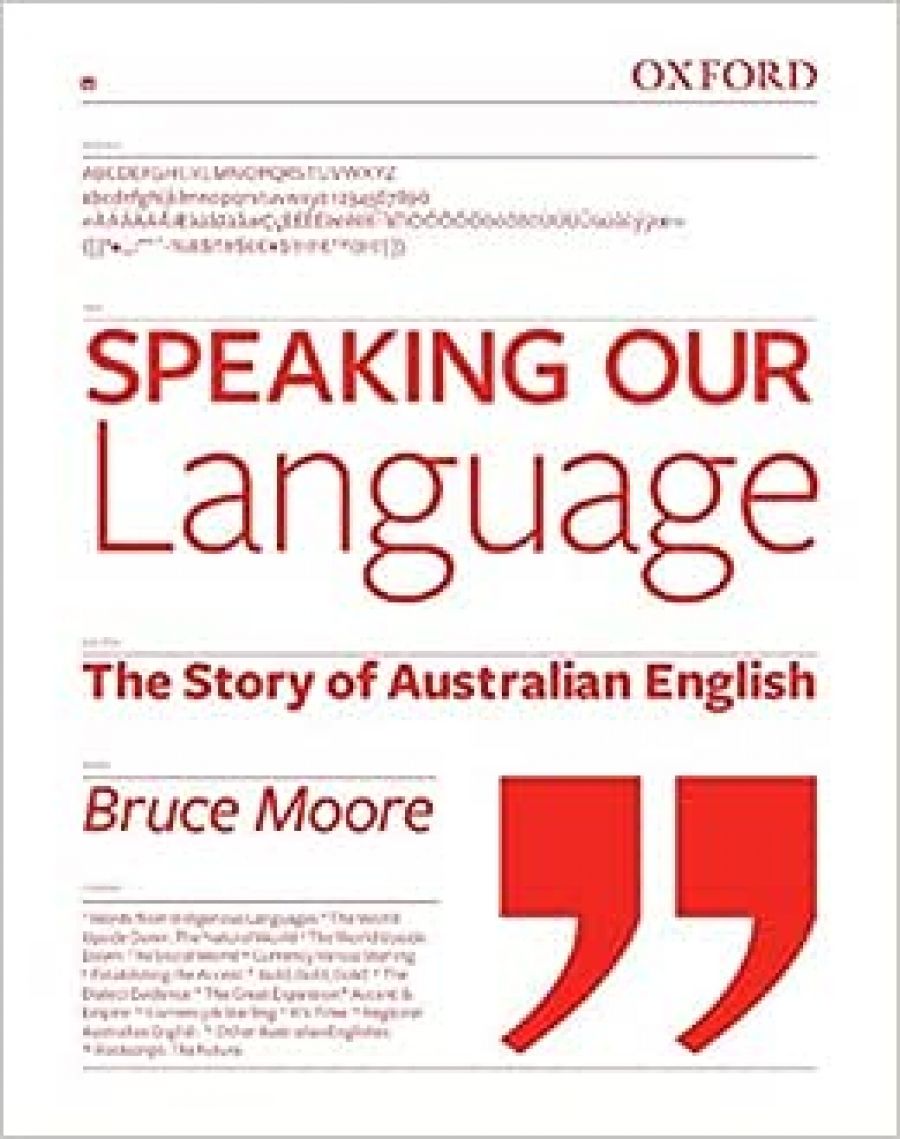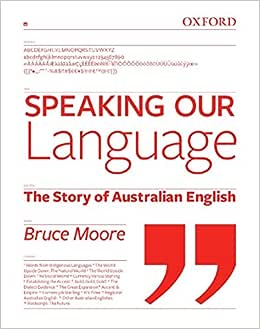
- Free Article: No
- Contents Category: Language
- Review Article: Yes
- Article Title: Biographer of words
- Online Only: No
- Custom Highlight Text:
Sir James Murray, the famous editor of the Oxford English Dictionary, believed that the dictionary-maker’s job was to furnish each word with a biography.
- Book 1 Title: Speaking our Language
- Book 1 Subtitle: The story of Australian English
- Book 1 Biblio: OUP, $29.95 pb, 225 pp
- Book 1 Cover Small (400 x 600):

Moore takes readers on an exploration of Australia’s past, present and future through its language. When it comes to Australian words, it is hard to find anyone who knows them better than the second (and current) director of the Australian National Dictionary Centre, at the Australian National University. Our famously vivid language reflects an equally colourful history, and Moore turns out to be a consummate storyteller. From the opening story of the Australian word, kangaroo, introduced to British high society by Samuel Johnson impersonating the animal at a dinner party with Boswell, to the final reassurance that our language is stable and relatively resistant to Americanisms, this book is both entertaining and informative.
The story begins with the arrival of Europeans and the linguistic misunderstandings that occurred between them and the indigenous population. Initially, the white settlers did not know that there were 250 distinct Aboriginal languages, and presumed that the Aborigines spoke one language. This caused confusion when members of the First Fleet tried to speak to the Aborigines of the Sydney region using the dictionary of Guugu Yimidhirr, which Joseph Banks had written while the Endeavour was stranded at Cooktown for seven weeks. The Cooktown word kanguru did not match the Sydney word patagaram, so the Aborigines of New South Wales presumed that the word ‘kangaroo’ was the generic English term for ‘an animal’. Hence, when Europeans settled along the Darling River, the local Baaganndji people adopted the word ‘kangaroo’ as the name for the introduced animal ‘horse’. The first European to realise that more than one Aboriginal language existed was Watkin Tench, a member of the First Fleet’s marine corps, whom readers may recognise as ‘Talbot Silk’ in Kate Grenville’s new novel, The Lieutenant (2008).
Moore has an eye for the good story that connects words with people and historical events, and keeps the reader fascinated, but his overarching narrative is never far away. He argues convincingly for two pivotal decades in the evolution of Australian English: the 1890s and the 1960s. Both these decades were characterised by dual interests in language and nationalism, as evidenced by a flurry of publications on both topics. Throughout most of the nineteenth century, there was only one Australian accent and it was praised for being ‘pure’ (free of any elements of British dialects). But by the end of the century it began to be criticised and judged as inferior. Moore believes that this was a consequence of the establishment of a linguistic ‘standard’ in Britain, against which other varieties started to be judged.
While some scholars trace the notion of a ‘standard’ to late eighteenth-century London, Moore suggests that it occurred a century later, specifically in 1869, with the labelling of British Received Pronunciation (RP) by the English linguist A.J. Ellis. He goes on to argue that this prompted a prescriptivist attitude towards Australian vowels and diphthongs in the late nineteenth century, and the language began to be considered vulgar, brutal, ugly and objectionable. In reaction, the 1890s saw the emergence of a new ‘Cultivated’ accent in Australia, aided by school inspectors and elocution lessons. These linguistic changes coincided with de- bates about Federation, and with the appearance of the first dictionaries of Australian English. Once the Cultivated accent was established, a reactive accent known as ‘Broad Australian’ emerged. As Moore explains, this accent was ‘a deliberate rejection of Cultivated Australian by those for whom it was invented’. The main influences on our language in the early twentieth century were what Moore calls ‘the myths of British Imperialism and Australian Nationalism’ – in competition, collision, and often collusion with each other.
The second pivotal moment, the 1960s, saw an increase in nationalism and a number of publications on Australian English, in a trend that was reminiscent of the 1890s; a re- orientation away from empire, and an increase in the cultural and economic distance between Australia and Britain when the latter entered into the European Economic Com- munity (and Australians lost their automatic right to health- care, employment, and social security on entry to Britain); and the ‘naturalisation’ of Australian English and acceptance of it as the national language. Moore shows that a consequence of the renewed national identity since the 1960s has been a decrease in the extremes of Australian accent. His thesis is supported by the research of scholars such as Barbara Horvath, who found falling numbers of speakers of Broad Australian and Cultivated Australian. Today, Moore believes, Cultivated Australian has lost its status and Broad Australian merely holds comical status (think of Kath and Kim). Soon these extremes will disappear, and Moore predicts we will have come full circle, and be ‘back with the situation that characterised the nineteenth century – most Australians speaking with much the same accent’. This means that the ‘broad’ accents of Pauline Hanson and Paul Hogan, as well as the ‘cultivated’ accents of Malcolm Fraser and Alexander Downer, are endangered, while the more ‘general’ accent of Kevin Rudd, Andrew Denton and Gabriella Cilmi represents the voice of the future.
Moore has the rare gift of presenting scholarly information in a way that is accessible to generalists and scholars alike. How could anyone make the dry linguistic science of phonetics and phonology remotely interesting? But Moore does, through the story of one of Australia’s most colourful characters, Ned Kelly. Moore asks why most characterisations of Kelly in film have portrayed him with an Irish accent, when by this stage in Australia’s history (the mid nineteenth century) Ned Kelly’s accent would have been Australian, not Irish. Using Kelly as a prototypical example of an Australian-born child with British parents, Moore discounts previous theories that first-generation Australians in the nineteenth century spoke either Irish or Cockney. Rather, he argues that the Australian accent was forged in the levelling of dialects that occurred in the children of the first generation of convicts, freed convicts, free settlers and administrators. Moore uses references to the Australian accent in nineteenth-century travellers’ tales to conclude that the accent was fully established by 1832.
One feature of English in Australia that has puzzled academics for decades is its homogeneity. Given the vast size of our continent, why is there such minimal regional difference in our English? Moore’s explanation is that the Australian accent was formed in Sydney and this foundation accent spread from Sydney to the other colonies, remaining uniform in the process.
Speaking Our Language fills a serious gap in the current market of books on Australian English, which are either trivial texts in airports on ‘Strine for Pommy Bastards’ or scholarly collections of essays on features of Australian English such as hypocoristics (the Australian habit of putting -ie on the end of words, like mozzie and Chrissie prezzie) or high rising tone (making a statement sound like a question). Moore’s study strikes the perfect balance of accessibility and coverage, while not shying away from complexity. A chronological study of this kind has not been attempted since the publication of W.S. Ramson’s Australian English: An Historical Study of the Vocabulary 1788–1898 (1966).
This book challenges scholars to re-evaluate their theories on the emergence and stabilisation of Australian English. In particular, it would be useful to compare Moore’s thesis on 1890s and 1960s as the pivotal decades with Edgar Schneider’s ‘dynamic model’, which singles out the 1830s, 1901, 1942 and the 1980s as pivotal. Schneider’s landmark text Postcolonial English: Varieties around the World (2007) does not appear in Moore’s bibliography, which is otherwise quite comprehensive. The book would have benefited from an index and a fuller list of words at the back. Perhaps these can be added to future editions.
I have no doubt that there will be future editions of this book. It is a masterly piece of work, a welcome and much-needed addition to the literature, and one that I would recommend to anyone keen to know more about Australian language, culture and history. Bruce Moore has succeeded in placing words in their historical context while telling a story of nationhood. James Murray would be proud.


Comments powered by CComment